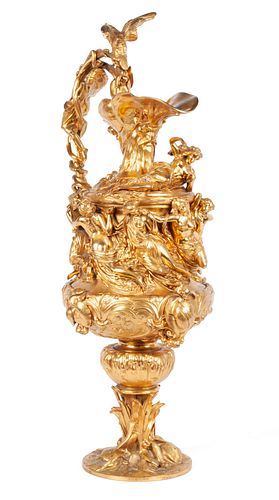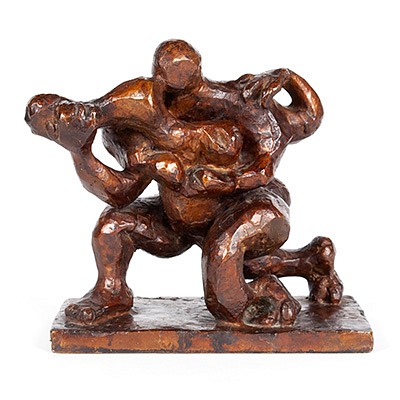A RARE LEONARD MOREL-LADEUIL (1820-1888) BELLE EPOQUE FIRE GILT BRONZE EWER
About Seller
555 Washington Ave, Ste 129
St. Louis, MO 63101
United States
Two ways to bid:
- Leave a max absentee bid and the platform will bid on your behalf up to your maximum bid during the live auction.
- Bid live during the auction and your bids will be submitted real-time to the auctioneer.
Bid Increments
| Price | Bid Increment |
|---|---|
| $0 | $5 |
| $30 | $10 |
| $100 | $25 |
| $500 | $50 |
| $1,000 | $100 |
| $3,000 | $250 |
| $5,000 | $500 |
| $10,000 | $1,000 |
| $30,000 | $2,500 |
| $50,000 | $5,000 |
| $100,000 | $10,000 |
| $300,000 | $25,000 |
| $500,000 | $50,000 |
About Auction
Jul 15, 2023
Period furniture and art entangle dramatically with modern and contemporary works. Selkirk Auctioneers & Appraisers info@selkirkauctions.com
- Lot Description
A RARE LEONARD MOREL-LADEUIL (1820-1888) BELLE EPOQUE FIRE GILT BRONZE EWER
Dance of the Wilis
Continental, mid-19th century, bronze. Crowned with the figure of an owl with outstretched wings at the top of the handle overlooking the ewer adorned in Art Nouveau fashion with cattails, lily pads, and nine wilis, a reclining figure across the shoulder of the vessel (Myrtha) playing kymbala.
A scene after the ballet Giselle, depicting the wilis, who are spirits of young virgins betrayed by men and having died of heartbreak, take revenge in the night by dancing men to death by exhaustion.
Léonard Morel-Ladeuil (1820 - 15 March 1888), French goldsmith and sculptor, was born at Clermont-Ferrand, and would be regarded as one of the most expert of French chasers, and a pioneer in the art of repousse, as well as master to Tiffany silversmith Eugene J. Soligny. He was apprenticed first to Morel, a manufacturer of bronzes, then to Antoine Vechte, and quickly absorbed the skill of both. He studied further under JJ Fuchre, during which time he caught the eye of the comte d'Orsay and the duc de Morny, through whose recommendation the French government, desirous of popularizing the idea of the new Imperialism, commissioned him to produce the Empire Shield.
Napoleon III notified his warm approval, but the trade, annoyed that a craftsman should obtain commissions direct, resented the innovation and thenceforward boycotted the young artist, whose newest work and the piece offered, Dance of the Willis none would take. He was encouraged, nevertheless by a foreign dealer in Paris, Marché, who employed him on statuettes, mainly religious in character, until 1859, when Messrs Eikington, in view of the Great Exhibition of 1862, engaged him to work for Elkington Silversmiths in Birmingham for three years in repoussé.
Following his silver "Night came Day," and then the "Inventions" vase, which placed him at once at the top of his profession, came the beautiful plateau called "Dreams," which was subscribed for (£500) by Birmingham as the town wedding-gift to the prince and princess of Wales. Morel-Ladeuil's contract was then renewed for five years, though in full he spent twenty-three years at their London house. His masterpiece the "Milton Shield: Paradise Lost", in repoussé steel and silver, was the sensation of the Paris Exhibition. It was bought by the English government for £3000, and thousands of copies made by galvanoplastie or electrotype were sold and spread all over the world. Another masterpiece, the "Helicon Vase", was presented by the ladies and gentlemen of the royal house to Queen Victoria on her first jubilee. Decorated with gold damascening by the Spanish craftsman Plácido Zuloaga, it was described on its exhibition as "one of the greatest Art productions of the century". For the Philadelphia Exhibition of 1876 Morel-Ladeuil produced "A Pompeian Lady at her Toilet," followed by the "Bunyan Shield," a companion to the Milton. After the reliefs "The Merry Wives of Windsor," "The Merchant of Venice," and "Much Ado about Nothing," and suffering from poor health, Morel-Ladeuil retired to Boulogne, where he died of angina pectoris on 15 March 1888, and was buried with much ceremony at Clermont-Ferrand.
26 1/4 in. (66.7 cm.); 16.3293 kg (36 lbs.)Originally, this piece would be accompanied by an underplate (though its grandeur remains uncompromised).Condition
Any condition statement is given as a courtesy to a client, is an opinion, and should not be treated as a statement of fact. Reference to condition written, oral or within a condition report shall not be regarded as a full account of condition and may not include all defects, alterations, or restorations. Absence of a condition report does not imply a lot is flawless or lacking imperfections or damage. Selkirk Auctioneers & Appraisers shall have no responsibility for any error or omission. Returns shall not be accepted on the basis of condition. - Shipping Info
-
The buyer is responsible for arranging pick-up and shipment of all purchased lots. All registered bidders are responsible for obtaining quotes through in-house shipping or a third-party shipping agent, in advance of bidding. A list of third-party shippers is made available on Selkirk’s website, as well as at the time of invoicing. Not all items are eligible for in-house shipping. Selkirk will not be responsible for any loss, damage, theft, or otherwise responsible for any items left in Selkirk’s possession ten (10) days after the sale. If arrangements for shipping have not been made and communicated within thirty (30) days, Selkirk reserves the right, at this time, to charge a storage fee of $10 per lot per day for furniture and large format items and $5 per lot per day for all other items, and within sixty (60) days, at its own discretion, sell any items left on the premises. Accumulated fees resulting from storage and insurance cost will be taken out of any proceeds. Objects that contain materials of endangered or protected species may be subject to regulations disallowing export and import into other states or countries. It is the buyer’s responsibility to be aware of all applicable laws and regulations and to obtain any required export or import licenses or certificates and any other required documentation. Disputes arising from damage incurred during in-house shipping are subject to the terms and conditions of filing a shipping insurance claim and of no guarantee.
-
- Buyer's Premium



 EUR
EUR CAD
CAD AUD
AUD GBP
GBP MXN
MXN HKD
HKD CNY
CNY MYR
MYR SEK
SEK SGD
SGD CHF
CHF THB
THB






















